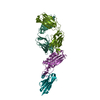+Search query
-Structure paper
| Title | Neutralizing nanobodies bind SARS-CoV-2 spike RBD and block interaction with ACE2. |
|---|---|
| Journal, issue, pages | Nat Struct Mol Biol, Vol. 27, Issue 9, Page 846-854, Year 2020 |
| Publish date | Jul 13, 2020 |
 Authors Authors | Jiandong Huo / Audrey Le Bas / Reinis R Ruza / Helen M E Duyvesteyn / Halina Mikolajek / Tomas Malinauskas / Tiong Kit Tan / Pramila Rijal / Maud Dumoux / Philip N Ward / Jingshan Ren / Daming Zhou / Peter J Harrison / Miriam Weckener / Daniel K Clare / Vinod K Vogirala / Julika Radecke / Lucile Moynié / Yuguang Zhao / Javier Gilbert-Jaramillo / Michael L Knight / Julia A Tree / Karen R Buttigieg / Naomi Coombes / Michael J Elmore / Miles W Carroll / Loic Carrique / Pranav N M Shah / William James / Alain R Townsend / David I Stuart / Raymond J Owens / James H Naismith /  |
| PubMed Abstract | The SARS-CoV-2 virus is more transmissible than previous coronaviruses and causes a more serious illness than influenza. The SARS-CoV-2 receptor binding domain (RBD) of the spike protein binds to the ...The SARS-CoV-2 virus is more transmissible than previous coronaviruses and causes a more serious illness than influenza. The SARS-CoV-2 receptor binding domain (RBD) of the spike protein binds to the human angiotensin-converting enzyme 2 (ACE2) receptor as a prelude to viral entry into the cell. Using a naive llama single-domain antibody library and PCR-based maturation, we have produced two closely related nanobodies, H11-D4 and H11-H4, that bind RBD (K of 39 and 12 nM, respectively) and block its interaction with ACE2. Single-particle cryo-EM revealed that both nanobodies bind to all three RBDs in the spike trimer. Crystal structures of each nanobody-RBD complex revealed how both nanobodies recognize the same epitope, which partly overlaps with the ACE2 binding surface, explaining the blocking of the RBD-ACE2 interaction. Nanobody-Fc fusions showed neutralizing activity against SARS-CoV-2 (4-6 nM for H11-H4, 18 nM for H11-D4) and additive neutralization with the SARS-CoV-1/2 antibody CR3022. |
 External links External links |  Nat Struct Mol Biol / Nat Struct Mol Biol /  PubMed:32661423 PubMed:32661423 |
| Methods | EM (single particle) / X-ray diffraction |
| Resolution | 3.3 - 3.7 Å |
| Structure data | EMDB-11068, PDB-6z43: EMDB-11218, PDB-6zhd:  PDB-6zh9: |
| Chemicals |  ChemComp-NAG: |
| Source |
|
 Keywords Keywords |  VIRAL PROTEIN / Spike / VIRAL PROTEIN / Spike /  nanobody / VHH / nanobody / VHH /  SARS-CoV-2 / SARS-CoV-2 /  COVID-19 / COVID-19 /  ANTIVIRAL PROTEIN / ANTIVIRAL PROTEIN /  Covid19 / Covid19 /  llama / neutralisation llama / neutralisation |
 Movie
Movie Controller
Controller Structure viewers
Structure viewers About Yorodumi Papers
About Yorodumi Papers










